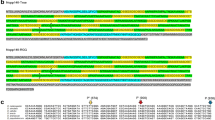Summary
Themastermind gene ofDrosophila melanogaster encodes a novel, highly repetitive nuclear protein required for neural development. To identify functionally important regions we have initiated an interspecific comparison of the gene inDrosophila virilis. Mastermind transcription and genomic organization are similar in both species and sequence analysis reveals significant conservation in a major cluster of charged amino acids. In contrast, extensive variation is noted in homopolymer domains that immediately flank the acidic cluster. Distinct patterns of evolutionary change can be identified: the major difference between unique regions are occasional amino acid substitutions whereas the repetitive areas are characterized by numerous large in-frame insertions/deletions and a nearly threefold higher rate of amino acid replacement. Conservation of the acidic domain suggests that it has an important functional role whereas the hypervariable homopolymer regions appear to be under less selective constraints than adjacent unique areas.
Similar content being viewed by others
References
Bankier AT, Barrell BG (1983) Shotgun DNA sequencing. In: Flavell R (ed) Techniques in nucleic acid biochemistry. Elsevier, Ireland, pp 1–34
Beachy PA, Helfand SL, Hogness DS (1985) Segmental distribution ofbithorax complex proteins duringDrosophila development. Nature 313:545–551
Beverley SM, Wilson AC (1984) Molecular evolution inDrosophila and higher Diptera. II. A time scale for fly evolution. J Mol Evol 21:1–13
Brendel V, Karlin S (1989) Association of charge clusters with functional domains of cellular transcription factors. Proc Natl Acad Sci USA 86:5698–5702
Danielson M, Northrop JP, Ringold GM (1986) The mouse glucocorticoid receptor: mapping of functional domains by cloning, sequencing and expression of wild-type and mutant receptor proteins. EMBO J 5:2513–2522
Dover GA (1986) Molecular drive in multigene families: how biological novelties arise, spread and are assimilated. Trends Genet 2:159–165
Faulkner DV, Jurka J (1988) Multiple aligned sequence editor (MASE). Trends Biochem Sci 13:321–322
Kassis JA, Poole SJ, Wright DK, O'Farrell PH (1986) Sequence conservation in the protein coding and intron regions of theengrailed transcription unit. EMBO J 5:3583–3589
Laughon A, Carrol SB, Storter FA, Riley PD, Scott MP (1985) Common properties of proteins encoded by theAntennapedia complex genes ofDrosophila melanogaster. Cold Spring Harbor Symp Quant Biol 50:253–262
Lehmann R, Jimenez F, Dietrich U, Campos-Ortega JA (1983) On the phenotype and development of mutants of early neurogenesis inDrosophila melanogaster. Wilhelm Roux' Arch Dev Biol 192:62–74
Michael WM, Bowtell DL, Rubin GM (1990) Comparison of thesevenless genes ofDrosophila virilis andDrosophila melanogaster. Proc Natl Acad Sci USA 87:5351–5353
Moriyama EN (1987) Higher rates of nucleotide substitution inDrosophila than in mammals. Jpn J Genet 62:139–147
Sambrook J, Fritsch EF, Maniatis T (1988) Molecular cloning: a laboratory manual, ed 2. Cold Spring Harbor Laboratory, Cold Spring Harbor NY
Smith RF, Smith TF (1990) Automatic generation of primary sequence patterns from sets of related protein sequences. Proc Natl Acad Sci USA 87:118–122
Smoller D, Friedel C, Schmid A, Bettler D, Lam L, Yedvobnick B (1990) TheDrosophila neurogenic locusmastermind encodes a nuclear protein unusually rich in amino acid homopolymers. Genes & Dev 4:1688–1700
Staden R (1986) The current status and portability of our sequence handling software. Nucleic Acids Res 14:217–231
Tautz D (1989) Hypervariability of simple sequences as a general source for polymorphic DNA markers. Nucleic Acids Res 17:6463–6471
Tautz D, Trick M, Dover GA (1986) Cryptic simplicity in DNA is a major source of genetic variation. Nature 322:652–656
Treier M, Pfeifle C, Tautz D (1989) Comparison of the gap segmentation genehunchback betweenDrosophila melanogaster andDrosophila virilis reveals novel modes of evolutionary change. EMBO J 8:1517–1525
Weber JL, May EP (1989) Abundant class of human DNA polymorphism which can be typed using the polymerase chain reaction. Am J Hum Genet 44:388–396
Weigel D, Knust E, Campos-Ortega JA (1987) Molecular organization ofmastermind, a neurogenic gene ofDrosophila melanogaster. Mol Gen Genet 207:374–384
Wharton KA, Yedvobnick B, Finnerty VG, Artavanis-Tsakonas S (1985) Opa: a novel family of transcribed repeats shared by theNotch locus and other developmentally regulated loci inD. melanogaster. Cell 40:55–62
Yedvobnick B, Smoller D, Young P, Mills D (1988) Molecular analysis of the neurogenic locusmastermind ofDrosophila melanogaster. Genetics 118:483–497
Author information
Authors and Affiliations
Rights and permissions
About this article
Cite this article
Newfeld, S.J., Smoller, D.A. & Yedvobnick, B. Interspecific comparison of the unusually repetitiveDrosophila locusmastermind . J Mol Evol 32, 415–420 (1991). https://doi.org/10.1007/BF02101281
Received:
Accepted:
Issue Date:
DOI: https://doi.org/10.1007/BF02101281



